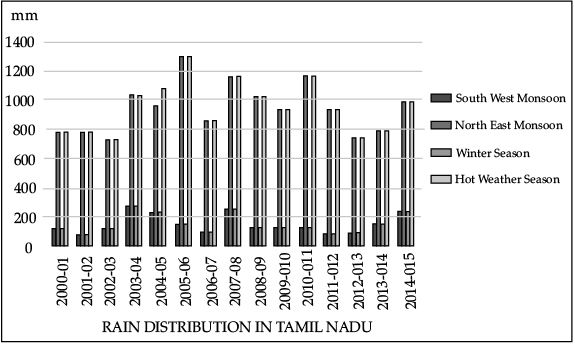Humanities/Arts Exam > Humanities/Arts Questions > Direction: Study the given graph of annual ra...
Start Learning for Free
Direction: Study the given graph of annual rain distribution in Tamil Nadu (2017) carefully and answer any three of the questions that follow :

Q. Which year received the maximum rain from North East Monsoon?
- a)2003-04
- b)2005-06
- c)2007-08
- d)2010-11
Correct answer is option 'B'. Can you explain this answer?
Verified Answer
Direction: Study the given graph of annual rain distribution in Tamil ...
In 2005-06 we received the maximum rain from North East Monsoon.

|
Explore Courses for Humanities/Arts exam
|

|
Similar Humanities/Arts Doubts
Direction: Study the given graph of annual rain distribution in Tamil Nadu (2017) carefully and answer any three of the questions that follow :Q. Which year received the maximum rain from North East Monsoon?a)2003-04b)2005-06c)2007-08d)2010-11Correct answer is option 'B'. Can you explain this answer?
Question Description
Direction: Study the given graph of annual rain distribution in Tamil Nadu (2017) carefully and answer any three of the questions that follow :Q. Which year received the maximum rain from North East Monsoon?a)2003-04b)2005-06c)2007-08d)2010-11Correct answer is option 'B'. Can you explain this answer? for Humanities/Arts 2025 is part of Humanities/Arts preparation. The Question and answers have been prepared according to the Humanities/Arts exam syllabus. Information about Direction: Study the given graph of annual rain distribution in Tamil Nadu (2017) carefully and answer any three of the questions that follow :Q. Which year received the maximum rain from North East Monsoon?a)2003-04b)2005-06c)2007-08d)2010-11Correct answer is option 'B'. Can you explain this answer? covers all topics & solutions for Humanities/Arts 2025 Exam. Find important definitions, questions, meanings, examples, exercises and tests below for Direction: Study the given graph of annual rain distribution in Tamil Nadu (2017) carefully and answer any three of the questions that follow :Q. Which year received the maximum rain from North East Monsoon?a)2003-04b)2005-06c)2007-08d)2010-11Correct answer is option 'B'. Can you explain this answer?.
Direction: Study the given graph of annual rain distribution in Tamil Nadu (2017) carefully and answer any three of the questions that follow :Q. Which year received the maximum rain from North East Monsoon?a)2003-04b)2005-06c)2007-08d)2010-11Correct answer is option 'B'. Can you explain this answer? for Humanities/Arts 2025 is part of Humanities/Arts preparation. The Question and answers have been prepared according to the Humanities/Arts exam syllabus. Information about Direction: Study the given graph of annual rain distribution in Tamil Nadu (2017) carefully and answer any three of the questions that follow :Q. Which year received the maximum rain from North East Monsoon?a)2003-04b)2005-06c)2007-08d)2010-11Correct answer is option 'B'. Can you explain this answer? covers all topics & solutions for Humanities/Arts 2025 Exam. Find important definitions, questions, meanings, examples, exercises and tests below for Direction: Study the given graph of annual rain distribution in Tamil Nadu (2017) carefully and answer any three of the questions that follow :Q. Which year received the maximum rain from North East Monsoon?a)2003-04b)2005-06c)2007-08d)2010-11Correct answer is option 'B'. Can you explain this answer?.
Solutions for Direction: Study the given graph of annual rain distribution in Tamil Nadu (2017) carefully and answer any three of the questions that follow :Q. Which year received the maximum rain from North East Monsoon?a)2003-04b)2005-06c)2007-08d)2010-11Correct answer is option 'B'. Can you explain this answer? in English & in Hindi are available as part of our courses for Humanities/Arts.
Download more important topics, notes, lectures and mock test series for Humanities/Arts Exam by signing up for free.
Here you can find the meaning of Direction: Study the given graph of annual rain distribution in Tamil Nadu (2017) carefully and answer any three of the questions that follow :Q. Which year received the maximum rain from North East Monsoon?a)2003-04b)2005-06c)2007-08d)2010-11Correct answer is option 'B'. Can you explain this answer? defined & explained in the simplest way possible. Besides giving the explanation of
Direction: Study the given graph of annual rain distribution in Tamil Nadu (2017) carefully and answer any three of the questions that follow :Q. Which year received the maximum rain from North East Monsoon?a)2003-04b)2005-06c)2007-08d)2010-11Correct answer is option 'B'. Can you explain this answer?, a detailed solution for Direction: Study the given graph of annual rain distribution in Tamil Nadu (2017) carefully and answer any three of the questions that follow :Q. Which year received the maximum rain from North East Monsoon?a)2003-04b)2005-06c)2007-08d)2010-11Correct answer is option 'B'. Can you explain this answer? has been provided alongside types of Direction: Study the given graph of annual rain distribution in Tamil Nadu (2017) carefully and answer any three of the questions that follow :Q. Which year received the maximum rain from North East Monsoon?a)2003-04b)2005-06c)2007-08d)2010-11Correct answer is option 'B'. Can you explain this answer? theory, EduRev gives you an
ample number of questions to practice Direction: Study the given graph of annual rain distribution in Tamil Nadu (2017) carefully and answer any three of the questions that follow :Q. Which year received the maximum rain from North East Monsoon?a)2003-04b)2005-06c)2007-08d)2010-11Correct answer is option 'B'. Can you explain this answer? tests, examples and also practice Humanities/Arts tests.

|
Explore Courses for Humanities/Arts exam
|

|
Signup for Free!
Signup to see your scores go up within 7 days! Learn & Practice with 1000+ FREE Notes, Videos & Tests.


























